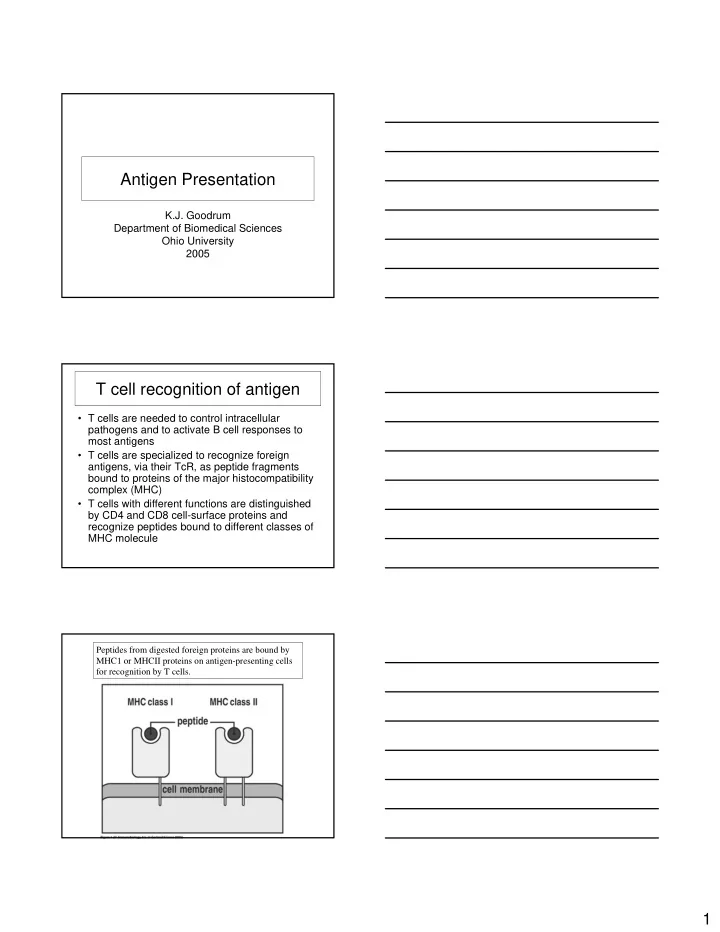

Antigen Presentation K.J. Goodrum Department of Biomedical Sciences Ohio University 2005 T cell recognition of antigen • T cells are needed to control intracellular pathogens and to activate B cell responses to most antigens • T cells are specialized to recognize foreign antigens, via their TcR, as peptide fragments bound to proteins of the major histocompatibility complex (MHC) • T cells with different functions are distinguished by CD4 and CD8 cell-surface proteins and recognize peptides bound to different classes of MHC molecule Peptides from digested foreign proteins are bound by MHC1 or MHCII proteins on antigen-presenting cells for recognition by T cells. 1
MHC II is a transmembrane glycoprotein ( α -chain) noncovalently bound with β 2-microglobulin. The folded molecule forms a peptide-binding cleft. MHC I is a transmembrane glycoprotein (noncovalently linked α and β glycoprotein chains). The folded molecule forms a peptide-binding cleft. MHC I is expressed on all nucleated cells (including APC). MHC II is expressed only on antigen presenting cells (APC; usually immune cells). 2
The MHC class I and class II molecules deliver peptides to the cell surface from two distinct intracellular compartments Peptides that bind to MHC I molecules are actively transported from the cytosol to the endoplasmic reticulum. Cytosol-derived peptides are loaded onto MHC I and MHCI- peptide complexes transported to the cell surface. Peptides that bind to MHC class II molecules are generated in acidified endocytic vesicles 3
Extracellularly-derived peptides or peptides from intravesicular pathogens are loaded onto MHC II and the MHC II-peptide complex is transported to the APC cell surface. T Cell Receptor for Antigen • T cells express a co-receptor (CD4 or CD8)which binds to the MHC portion of the composite MHC:peptide ligand. • Regulatory CD4-T helper cells recognize peptides complexed with Class II MHC on specialized antigen presenting cells. • Cytotoxic CD8-T cells recognize peptides complexed with Class I MHC on any nucleated cell. CD4 and CD8 proteins act as co-receptors to restrict T cell interactions with MHI or MHCII and are used to identify functional T-helper (CD4+) vs. cytotoxic T cells (CD8+). Fig. 8.26 4
Major Histocompatibility Complex • Individuals inherit 2 complete sets of MHC genes (1 paternal + 1 maternal “haplotype”) • Both inherited alleles at each MHC gene locus are co-dominantly expressed. – An APC could thus express 6 different types of MHC I molecules and 6 different inherited types of MHC II molecules on its cell membrane 5
Major Histocompatibility Complex-2 • Different MHC bind different peptides • The polymorphic amino acid residues that distinguish MHC alleles determine the peptide-binding properties of different MHC molecules • A single MHC may bind many different peptides which share “sequence motifs” Major Histocompatibility Complex-3 • MHC genes = immune response genes (Ir) • Immune responsiveness to any single peptide depends on inheritance of an MHC molecule which can bind that peptide. 6
MHC Restriction • TcR recognizes a complex of antigenic peptide and MHC • A T cell specific for peptide x and a particular MHC allele (MHC a ) will not recognize the complex of peptide x with a different MHC allele (MHC b ) Summary Points • Processed peptides from intracellular (cytosolic) proteins form complexes with MHC I for presentation to CD8(+) Tc that destroy the self cell presenting foreign cytosolic proteins. • Processed peptides from acidic endocytic or phagocytic vesicles form complexes with MHC II for presentation to CD4(+) T helper cells that release cytokines to activate macrophage killing of intravesicular pathogens or to activate B cell antibody production for elimination of extracellular microbes. 7
Summary Points-2 • Virus-infected cells or tumor cells can be engulfed and processed by APC for activation of CD4(+)T-help needed by Tc activation. • Extracellular antigens are cross-presented by APC to both Th (via MHC II) and to Tc (via MHC I) 8
Recommend
More recommend